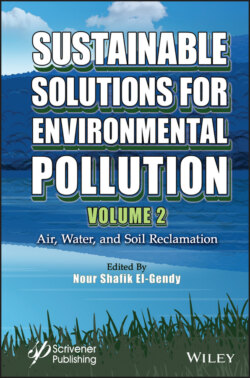Читать книгу Sustainable Solutions for Environmental Pollution, Volume 2 - Группа авторов - Страница 2
Table of Contents
Оглавление1 Cover
2 Title Page
3 Copyright
4 Preface
5 1 Natural-Based Solutions for Bioremediation in Water Environment 1.1 Introduction 1.2 Basic Principles 1.3 Aquatic Bioremediation Structures 1.4 Constructed Porous Ramps 1.5 Bank Filtration for Water Treatment 1.6 Constructed Wetlands (CWs) 1.7 Phytoremediation and Constructed Wetlands 1.8 Phycoremediation 1.9 Phytoremediation 1.10 Improving Bioremediation Systems 1.11 Animal Biodiversity 1.12 Nuisances 1.13 Wetland Monitoring 1.14 Wetland Modeling 1.15 Social Acceptance 1.16 Ecohydrology, an Integrative NBS Implementation 1.17 Conclusion Acknowledgement References
6 2 Removal of Heavy Metals From the Environment by Phytoremediation and Microbial Remediation 2.1 Introduction 2.2 Linking Heavy Metals Toxicity With Their Discharge and Removal From the Environmental Compartments 2.3 Bio-Alternative Approaches Used for Heavy Metals Removal and/or Recovery From the Environment 2.4 Interactions of Heavy Metals With Biological Systems and Toxicity Threats 2.5 Synergistic Use of Plants and Bacteria for Cleaning Up the Environment Polluted With Heavy Metals 2.6 Conclusions Acknowledgments References Website
7 3 Bioremediation as a Sustainable Solution for Environmental Contamination by Petroleum Hydrocarbons 3.1 Introduction 3.2 Principles of Bioremediation 3.3 Bioremediation and Biodegradation 3.4 Mechanism of Biodegradation 3.5 Bioremediation of Land Ecosystems 3.6 Bioremediation of Water Ecosystems 3.7 Challenges and Opportunities References
8 4 Pollution Protection Using Novel Membrane Catalytic Reactors Nomenclatures Greek Letters Abbreviations 4.1 Introduction 4.2 Autothermal Systems 4.3 The Thermal Coupling and the Autothermal (Auto) Reactors 4.4 The Membrane Reactor 4.5 Development Fischer-Tropsch Synthesis 4.6 HTFT Reactor Type and Developments 4.7 Membrane Reactors Classification 4.8 Rate Expressions 4.9 Industrial Applications 4.10 Catalytic Membrane Reactors Coupling Dehydro of EB to S With Hydro NB to A as a Case Study 4.11 Case Study of Use the Membranes in Fischer-Tropsch Reactors 4.12 Biofuel and Sustainability 4.13 Conclusions References
9 5 Removal of Microbial Contaminants From Polluted Water Using Combined Biosand Filters Techniques 5.1 Introduction 5.2 Slow Sand Filtration 5.3 Wetlands 5.4 Combination of Sand Filters With Constructed Wetlands Systems 5.5 Conclusions References
10 6 Biosurfactants: Promising Biomolecules for Environmental Cleanup 6.1 Introduction 6.2 Biosurfactants Types 6.3 Biosurfactants Mechanism of Remediation 6.4 Bioremediation of Petro-Hydrocarbon Contaminants 6.5 Microbial Enhance Oil Recovery (MEOR) 6.6 Biosurfactants and Agro-Ecosystem Pollutants 6.7 Heavy Metals Removal 6.8 Biosurfactants for Sustainability 6.9 Production Processes 6.10 Concluding Remarks 6.11 Future Aspects References
11 7 Metal Hyperaccumulation in Plants: Phytotechnologies 7.1 Introduction 7.2 Phytotechnologies and Terminologies 7.3 Biological Mechanisms 7.4 Present Gaps and Prospects 7.5 Conclusion Acknowledgements References
12 8 Microbial Remediation Approaches for PAH Degradation 8.1 Introduction 8.2 Biogeochemical Properties and Sources of PAH 8.3 Fate of PAH 8.4 PAH: Soil and Air Pollution 8.5 Harmful Effects of PAH 8.6 Microbe Assisted Biodegradation 8.7 Genes and Enzymes Involved in Microbial Degradation 8.8 Factors Affecting Microbial Biodegradation 8.9 Bioremediation and Genetic Engineering 8.10 Conclusion and Future Prospects References
13 9 Biomorphic Synthesis of Nanosized Zinc Oxide for Water Purification 9.1 Introduction 9.2 Properties of ZnO NPs 9.3 Protocol for the Biosynthesis of ZnO NPs 9.4 Factors Affecting the Synthesis of ZnO Nanoparticles 9.5 Applications of Biologically Synthesized NPs 9.6 Mechanism of Biogenic Synthesis of ZnO NPs 9.7 Cytotoxicity of Nanoparticles 9.8 Conclusions and Future Outlook References
14 10 Pollution Dynamics of Urban Catchments 10.1 Introduction 10.2 Sustainability in Domestic Wastewater Treatment 10.3 Source Area Pollutant Generation Processes 10.4 Polluting Activities 10.5 Characterization of Urban Pollutants 10.6 The Fate and Transport of Urban Pollutants 10.7 Spatial Distribution of Urbans Pollutants 10.8 Case Study: City of Harare 10.9 Conclusions, Challenges, Opportunities, and/or Future Aspects References
15 11 Bioupgrading of Crude Oil and Crude Oil Fractions 11.1 Introduction 11.2 Microbial Enhanced Oil Recovery 11.3 Biotransformation of Heavy Crude Oil 11.4 Biorefining of Crude Oil 11.5 The Future of Biotechnology in the Refinery References
16 12 Recyclable Porous Adsorbents as Environmentally Approach for Greenhouse Gas Capture 12.1 Introduction 12.2 Classification of Porous Materials 12.3 Recyclability Routes of Biomass to Porous Carbons 12.4 Activation Routes Processes 12.5 CO2 Capture in Recyclable Porous Carbon Materials 12.6 CO2 Capture Mechanism in Porous Carbons 12.7 Prospects and Outlooks 12.8 Conclusion Acknowledgements References
17 About the Editor
18 Index
19 Also of Interest
20 Wiley End User License Agreement
